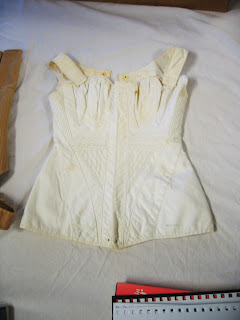I shall approach the construction starting with creating the right silhouette with the undergarments, from there I shall start cutting on the stand the bodice and skirt while flat drafting the basic two piece sleeve shape. The lattice decoration I shall leave until last to complete.
The undergarments I chose from the store are relatively appropriate for the time period and although i tried to get them as accurate as possible, this was not entirely achievable with the stock in the costume store, so I decided to look more at what shape they would create under the garment rather than them being completely historically accurate. I had trouble with finding a petticoat with the right shape that was also a good fit so I selected one that was accurate and slightly larger and tacked it in place onto the corset. This also helped it stay in the high waisted placement for my 1820's toile.

















































































